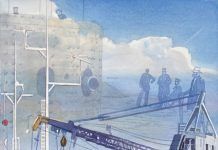By MC3 Theodore Quintana, Navy Office of Community Outreach
A 2013 Morse High School graduate and Spring Valley native is serving in Japan in the U.S. Navy aboard USS Germantown.
Seaman Tyron Pajel is a boatswain’s mate aboard the ship operating out of Sasebo, Japan.
By MC3 Theodore Quintana, Navy Office of Community Outreach
A 2013 Morse High School graduate and Spring Valley native is serving in Japan in the U.S. Navy aboard USS Germantown.
Seaman Tyron Pajel is a boatswain’s mate aboard the ship operating out of Sasebo, Japan.
A Navy boatswain’s mate is responsible for maintaining the exterior surfaces of the ships, deck handling and equipment, handling cargo and operating small boats
“I like the operations portion of my job, like the lifting and the mooring,” said Pajel.
With more than 50 percent of the world’s shipping tonnage and a third of the world’s crude oil passing through the region, the U.S. has historic and enduring interests in this part of the world.
“Our alliance is rooted in shared interests and shared values,” said Adm. Harry Harris, U.S. Pacific Command Commander. “It’s not hyperbole to say that the entire world has benefited from the U.S.-Japan alliance. While our alliance helped stabilize the region after the Second World War, it also enabled the Japanese people to bring about an era of unprecedented economic growth. And for the last six decades, our Soldiers, Sailors, Airmen, Marines and Coast Guardsmen have worked side by side with the Japan Self Defense Force to protect and advance peace and freedom.”
Commissioned in 1986, Germantown is the second Navy ship named after the Revolutionary War Battle of Germantown. With a crew of more than 900 sailors and Marines, Germantown is 609 feet long and weighs approximately 16,000 tons. Designed specifically to operate landing craft air cushion small craft vessels, Whidbey Island-class dock landing ships have the largest capacity for these landing craft out of any U.S. Navy amphibious ship.
“Everyone at this command are all motivated and we keep each others morale up,” said Pajel.
Sea duty is inherently arduous and challenging but it builds strong fellowship and esprit de corps among members of the crew. The crew is highly motivated and quickly adapt to changing conditions. It is a busy life of specialized work, watches, and drills.
“Serving in the Navy means I get to serve my country while experiencing new things and seeing the world,” said Pajel.
The Navy’s presence in Sasebo is part a long-standing commitment.
“The U.S.-Japan alliance remains the cornerstone for peace and stability in the Indo-Asia-Pacific region,” said Harris.














